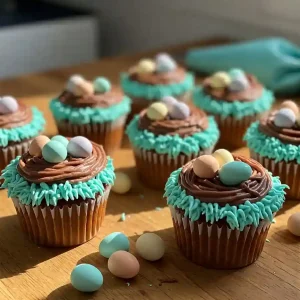Who else gets way too excited seeing all the chocolate eggs pop up around Easter? I definitely do.
But here’s the thing—homemade ones taste so much better, and they’re a whole lot more fun to make.
These Easter chocolate eggs are smooth, shiny, and filled with that rich, milky flavor you expect from a proper chocolate treat.
And let’s not forget the part everyone secretly loves: decorating them! I’m talking pastel swirls, zigzags, dots, hearts—the whole works.
Honestly, this feels less like “baking” and more like an afternoon of arts and crafts… but you get chocolate at the end.
I always end up with chocolate on my fingers, but that’s part of the fun, right? Make a batch for Easter, and trust me, no one will believe you didn’t pick them up from some fancy shop.
Table of Contents
ToggleEaster Chocolate Eggs Recipe
Ingredients
- 400g good-quality milk chocolate (chopped finely)
- 150g white chocolate (chopped finely)
- Gel food coloring (pastel shades: purple, pink, green, blue)
- 1 tablespoon coconut oil (for melting the chocolate smoothly)
- Piping bags or squeeze bottles (for decorating)
- Silicone Easter egg molds (medium size)
Instructions
- Melt the milk chocolate using a double boiler method: Place a heatproof bowl over a pot of simmering water (ensure the bowl does not touch the water). Stir the milk chocolate and coconut oil until fully melted and glossy.
- Remove from heat and allow the chocolate to cool slightly, about 5 minutes, to thicken just enough for coating.
- Spoon a generous amount of melted chocolate into each mold cavity. Use the back of the spoon or a pastry brush to evenly coat the inside of the molds. Make sure to build up a slightly thicker layer around the edges for stability.
- Flip the molds upside down onto a wire rack set over parchment paper to let excess chocolate drip off. Scrape the edges clean with a spatula.
- Chill the molds in the fridge for about 20-25 minutes or until the chocolate shells are completely set.
- Once set, carefully demold the chocolate halves. If the edges are uneven, warm a metal baking sheet slightly and gently press the edges onto it for a few seconds to smooth them out.
- To seal the two halves together, warm the edge of one half briefly on the warm baking sheet, then immediately press it against the matching half and hold gently for a few seconds until sealed. Repeat for all the eggs.
- Melt the white chocolate using the same double boiler method, stirring until smooth.
- Divide the melted white chocolate into separate small bowls depending on how many colors you plan to use.
- Tint each portion with a drop or two of pastel gel food coloring, mixing thoroughly until the desired color is achieved.
- Pour each colored chocolate into separate piping bags or squeeze bottles fitted with small round tips.
- Decorate each chocolate egg with swirls, zigzags, dots, hearts, waves, and other playful patterns. Aim for variety and symmetry, mimicking the patterns from the image.
- Let the decorated eggs set at room temperature or in the fridge for about 10-15 minutes until the decorations harden.

Helpful Tips For Making Chocolate Easter Eggs
- Pre-warm your molds slightly before adding the chocolate. Just a few seconds with a hairdryer or sitting near a warm oven helps the chocolate cling evenly to the mold and prevents streaks or air bubbles.
- Use the back of a spoon or pastry brush to push the chocolate up the sides of the mold. This guarantees the entire mold is coated properly, especially around the edges where chocolate tends to be thinner.
- For perfectly sealed eggs, warm a non-stick pan over very low heat and lightly press each half shell (open side down) onto the pan for 1-2 seconds. This melts the edges just enough to fuse them together tightly.
- Tap the filled molds on the counter gently but firmly to release hidden air pockets. Air bubbles cause weak spots that can crack when you pop the eggs out.
- Don’t just rely on tempering: mix two types of chocolate, like 70% dark and a sweeter milk chocolate. This balances flavor and improves melt and shine naturally due to the varied cocoa butter levels.
- Add a tiny pinch of fine salt to the melted chocolate. It subtly enhances the chocolate flavor without making it salty. It’s an old chocolatier trick.
- If you’re piping decorations, let the base chocolate shells come back to room temperature first before decorating. If the surface is too cold, the piping can set too fast and crack.
- Don’t overfill the molds with chocolate when coating. Thin, even layers give that nice crisp snap you want when biting into the egg.
- Layer your fillings: if adding nuts, dried fruits, or spreads inside, coat with chocolate first, chill, then add filling, and finally another layer of chocolate. This keeps the filling centered and prevents leaks.
Variations
There are plenty of ways to switch things up while keeping it fun and delicious:
- Use dark chocolate, milk chocolate, or white chocolate as your base depending on your taste.
- Fill the eggs with toffee pieces, roasted nuts, or dried fruits before sealing them.
- Add a layer of peanut butter, almond butter, or date paste inside for a creamy surprise.
- Decorate with colored chocolate, or switch to natural food powders like beetroot or matcha to tint your white chocolate.
- Make them extra playful by hiding mini marshmallows or fruit-flavored gummies inside the eggs.
- For extra crunch, sprinkle rice crisps, granola, or cookie crumbs inside the chocolate shells before sealing.
How To Store Chocolate Easter Eggs?
To keep your eggs fresh and looking great, here’s what you should do:
- Store them in an airtight container at room temperature, away from sunlight and heat.
- A cool, dark cupboard or pantry works well. Avoid the fridge unless your kitchen is too warm.
- If storing in the fridge, place them in a sealed container to prevent moisture from affecting the chocolate.
- Keep them away from strong-smelling foods like onions or spices, as chocolate can absorb odors.
Can You Freeze Chocolate Easter Eggs?
Yes, you can freeze them, but here’s what to know:
- Freeze them only if you need to store them long-term, like up to 2-3 months.
- Wrap each egg well with cling film or foil to protect it from freezer burn.
- Place the wrapped eggs in an airtight container or freezer bag.
- When ready to eat, thaw them slowly in the fridge overnight, then let them come to room temperature to avoid condensation on the surface.
How To Melt Chocolate For Chocolate Easter Eggs?
Melting chocolate the right way makes all the difference:
- Use a double boiler: Place a heatproof bowl over a pot with simmering water (don’t let the bowl touch the water) and stir until melted.
- Or melt it in the microwave: Heat chocolate in a microwave-safe bowl in short bursts of 15-20 seconds, stirring well after each burst.
- Add a little coconut oil while melting to help the chocolate stay smooth and glossy.

Why Is My Chocolate Setting Too Quickly?
If your chocolate is hardening faster than expected, here’s why:
- The room might be too cold, causing the chocolate to set fast.
- If you added too much coconut oil or butter, it could cause quicker setting.
- Tempered chocolate sets quicker than untempered chocolate.
To Slow It Down:
- Work in a slightly warmer room, around 20-22°C (68-72°F).
- Melt the chocolate gently so it doesn’t thicken too fast once off the heat.
Why Is My Chocolate Setting So Thick?
Thick chocolate can be tricky, but here’s what could be happening:
- The chocolate might have overheated, making it lose its smooth texture.
- If water got into the chocolate, even a little, it could have seized and turned lumpy.
- Using chocolate chips instead of good-quality bars sometimes leads to thicker melted chocolate as chips are made to hold shape.
To Fix It:
- Stir in a bit of melted coconut oil or vegetable oil to loosen it up.
- Always melt chocolate low and slow to keep it fluid and smooth.











